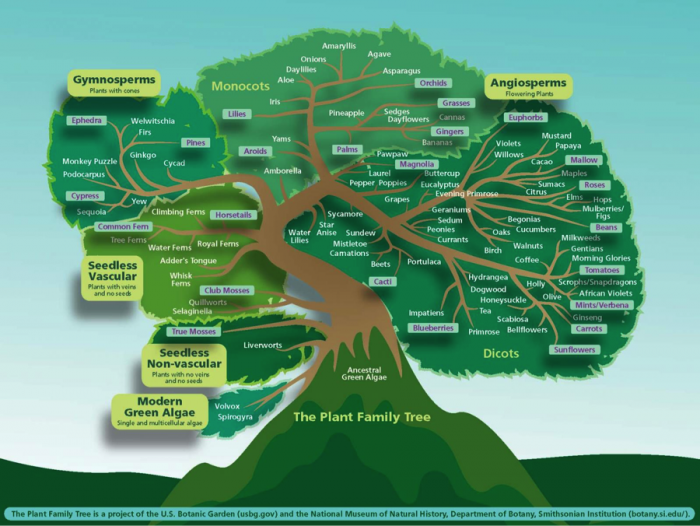
Organisms within a family have more in common than with organisms in any classification level above it. Because they share so much in common, organisms of a family are said to be related to each other. Genus is subdivision of family to describe the generic name for a similar group of organisms. A species is a further subdivision of Genus and often defined as a group of organisms that can reproduce naturally with one another and create fertile offspring. While that definition seems straightforward, the classification of a species can be difficult and at times riddled with controversy.
Plant families are groups of plants that are evolutionarily related and share similar anatomy and morphology, characteristics, such as reproductive structures and flowers. These families are separated based on structural differences in the plant’s fruit, seed, and flowers. The plant families are determined by the phenotype of the reproductive parts. An organism’s phenotype is all of its observable characteristics (See Figure 2).
Genera (and often even Species) in the same plant family often tend to have similar characteristics, nutrient needs, metabolics and often the same pests (pathogens, herbivores). Species within the Family due to similiar physiology are often distinguished and used similarly if not interchangeably in herbal medicine, food and other uses.
A diversified ecosystem of different plant genera and different plant families over time can interrupt the crop pest life cycles, particularly insect pests, and pathogens, and reduce yield losses due to pests yielding robust environmentally adapted plants to weather stresses such as frosts, and drought; different soil nutrient needs, as well as producing diverse foods that provide for human nutritional needs.
There’s a brief introduction to some of the main Plant Families here:
- Apiaceae (formerly Umbelliferae) – Celery or Carrot Family
- Apocynaceae – Periwinkle Family
- Asteraceae (formerly Compositae) – Daisy Family
- Bignoniaceae – Bignonia Family
- Boraginaceae – Forget-me-Not Family
- Brassicaceae (formerly Cruciferae) – Cabbage Family
- Caesalpiniaceae, Fabaceae, Mimosaceae, Papilionaceae (formerly Leguminosae) – Bean Family
- Campanulaceae – Bellflower Family
- Caryophyllaceae – Pink Family
- Clusiaceae (formerly Guttiferae) – St. John’s Wort Family
- Convolvulaceae – Bindweed Family
- Ericaceae – Heath Family
- Geraniaceae – Geranium Family
- Gesneriaceae – African Violet Family
- Hydrophyllaceae – Waterleaf Family
- Iridaceae – Iris Family
- Lamiaceae (formerly Labiatae) – Mint or Nettle Family
- Liliaceae – Lily Family
- Malvaceae – Mallow Family
- Musaceae – Banana Family
- Oxalidaceae – Wood Sorrel Family
- Papaveraceae – Poppy Family
- Plumbaginaceae – Leadwort Family
- Polemoniaceae – Phlox Family
- Primulaceae – Primrose Family
- Ranunculaceae – Buttercup Family
- Rosaceae – Rose Family
- Rubiaceae – Bedstraw Family
- Saxifragaceae – Saxifrage Family
- Scrophulariaceae – Figwort Family
- Solanaceae – Potato Family
- Violaceae – Violet Family
There are several hundred Plant Families, and the botanists are separating them into more every week, but it’s a start!
